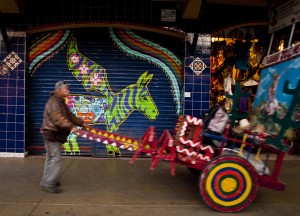The first thing I noticed about Tijuana when I moved here was how cool all the kids look. Punk kids with orange-dyed hair, torn up jackets & jeans, black Ramones t-shirts, piercings. Girls in animal print dresses and black leather boots.
Yet, while punk and hardcore and emo and metal are worldwide global youth cultures, there’s a particular sense of Tijuana style here that I love. I’m not sure what it is, but it feels very genuine, spontaneous. It feels good to be around it.
The graffiti scene here in Tijuana is no exception. Urban artists are embracing old images of the city like Tijuana’s Zonkey carts, and reviving them as an emblem of the new, hip Tijuana.
But along with official art interventions, unpermitted tagging and graffiti remains a vital part of Tijuana’s edgy urban aesthetic. But it’s not a style embraced by all.
On Sunday, March 11, 2012, the city of Tijuana sponsored “Graffiti Fest,” in conjunction with the Secretariats of Youth and Public Safety (la Secretaría de la Juventud de Tijuana (Sejuvet) y la Secretaría de Seguridad Pública Municipal (SSPM), to strike a balance between commercial Tijuana and its youth cultures and urban artists. The program was sponsored by the business leaders along Avenida Revolucion, says Juan Carlos Chairez Díaz, secretary of the Youth Office, to allow urban artists to express themselves freely, but within constraints that will enhance the overall urban and commercial environment of the Centro.
The fine line between urban art and vandalism continues to provoke anxiety among city leaders everywhere. Crackdowns on urban artists in San Diego and other parts of California are common, as Graffiti Task Force officials use databases to track artists, threaten them with felony charges and massive fines of tens of thousands of dollars. In California and Oregon, cities even assess fines to businesses who “tolerate” graffiti and urban art on their walls.
In this context, the move in Tijuana to create dialogue and cooperation between artists and businesses is a progressive step forward. Yet, it remains to be seen whether Tijuana will allow the vitality of its taggers and informal artists to shape the urban identity.
Like most city leaders elsewhere, Chairez Díaz suggests that the authorization of permitted urban art by events like Graffiti Fest will displace tagging and graffiti.
“Este evento es el primero de una campaña que será implementada en toda la ciudad, con la que estaremos buscando integrar a los artistas urbanos para que se expresen con más sentido; para que no lo hagan sólo de manera vandálica”
This event is the first in a campaign that will be implemented in the whole city, and we are looking to involve urban artists so they can genuinely express themselves, so that they don’t have to do this through vandalism,” explains Chairez Díaz.
There’s a sense of hope and excitement among young cultural leaders in the city today, and the dynamism and rapid growth of Tijuana seems to foster DIY experimentation.
It will be fascinating to see how this scene develops.
************
Stay tuned- CLICK HERE – for my slide show of photos from Graffiti Fest.
And check my Flickr Page for more Tijuana graffiti photos!

